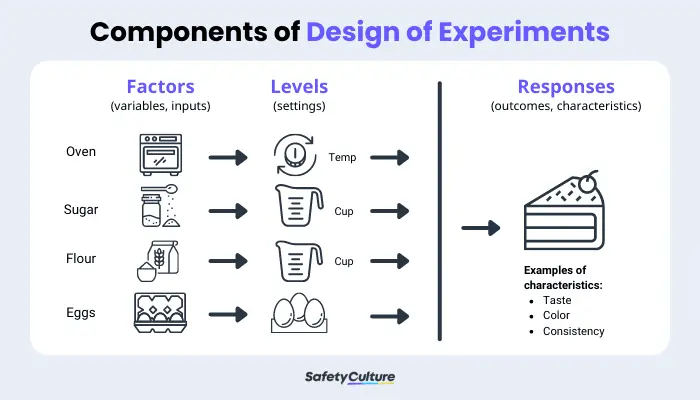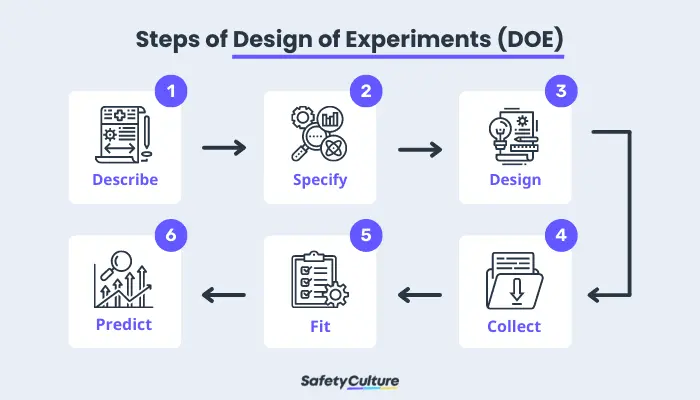What is Design of Experiments (DOE)?
Design of Experiments (DOE) is a systematic method used in applied statistics to evaluate the many possible alternatives in one or more design variables. It allows the manipulation of various input variables (factors) to determine what effect they could have in order to get the desired output (responses) or improve on the result.
In DoE, experiments are being used to find an unknown outcome or effect, to test a theory, or to demonstrate an already known effect. They are done by scientists and engineers, among others, in order to understand which inputs have a major impact on output and what input levels should be targeted to reach a desired outcome (output). Simply put, DoE is a way to collect information during the experiment and then determine what factors or which processes could lead to the desired result.
History of Design of Experiments
The term “Design of Experiments,” also known as experimental design, was coined by Ronald Fisher in the 1920s. He used it to describe a method of planning experiments to find the best combination of factors that affect the response or output. It is used to reduce design expenses because analysis of input parameters or factors gives way in identifying waste and which processes can be eliminated. It also helps remove complexities and streamlining the design process for cost management in the manufacturing process.
The key concept behind this methodology is that there is a relationship between the factors affecting the response. ISixSigma defined it as determining the “cause and effect relationships” of factors. Therefore, a complete experimental plan consists of the combination of factors used to evaluate their effects on the response.
Components of Experimental Design
MoreSteam gave a simple illustration to explain the components of the experiment—the three aspects that need to be analyzed in the design experiments—and understanding the meaning of each is crucial in defining DoE.

Cake-baking Process showing the Components of Experimental Design source: MoreSteam
- Factors or input parameters – they can be classified as either controllable or uncontrollable variables.
- Controllable variables – pertains to factors that can be modified or changed in an experiment or a process. For example, in the cake-baking process, these factors may include what will be used in baking such as the oven, sugar, flour, and eggs.
- Uncontrollable variables – pertains to factors that cannot be changed. For example, in the cake baking process, this may be the room temperature in the kitchen. They must be recognized to understand how they may affect the response.
- Levels or settings of each factor – they pertain to the quantity or quality that will be used in the experiment. In the cake-baking process example, this includes the oven temperature setting and the quantity of sugar, flour, and eggs.
- Responses – pertains to the outcome of the process that gages the desired effect. In the cake-baking example, the taste, appearance, and consistency of the cake are the responses. They are influenced by the factors and their levels. This is the purpose of experimentation—analyzing each factor to determine which of them provides the best overall outcome or the same quality.
Purpose of Design of Experiments
Experimental design is not only conducted by scientists or engineers. It can be used by different industries who want to maximize the results they’re getting. DoE is conducted to:
Compare alternatives
Conducting experimental design allows you to look at different alternatives. It helps in making an informed decision on what to use or what to change. This methodology can also be used to discover the best combination of alternatives in the experiment.
Maximize process response
With DoE, the factors and their levels are checked and see which of them when used are giving the exact quality in the response.
Reduce variations
Excess variations in the process are the cause of added expense. It affects the cycle time that causes quality differences. With DoE, factors are identified, responses are interpreted, and waste is eliminated or changed.
Process Improvement
Performing a DOE can uncover significant issues that are typically missed when conducting an experiment. These areas will be corrected thus improving the process.
Evaluate the effect of change/s
With DoE, you can determine the effects of changes made with the factors and their levels that influences the response.
Quality Control
DOE can also help improve manufacturing efficiency by identifying factors that reduce material and energy use, costs, and waiting time. It is also used to test a product or system before releasing it to market.
Digitize the way you Work
Empower your team with SafetyCulture to perform checks, train staff, report issues, and automate tasks with our digital platform.
Get Started for FreeExamples and Applications of Experimental Design
Below are some practical applications or examples on where DoE is applied:
Pharmaceutical Industry
In the pharmaceutical industry, DOE is most typically used throughout the drug formulation and manufacturing phases. Qualitty is critical for drug products because health and safety of consumers are at risk when a product doesn’t meet the standards. DoE is used in drug testing, reducing impurities in the process of making drugs, before releasing it for consumer use.
DoE is used especially in drugs that are best delivered via a time-release schedule,. It means that it takes time to dissolve slowly in the body. Because one component of DoE is the settings of factors, performing an experimental runs are applicable here.
Fast-Moving Consumer Goods (FMCG) industry
FMCG industry is a part of consumer goods industry that includes all the products which are sold to the general public by any means such as retail stores, internet or by phone. These are mostly used by the consumers in their daily life and may include food, drinks, health and hygiene, cosmetics, household appliances, among others. DoE helps in comparing alternatives or options to get the response where price will be cheaper but does not compromise on quality.
Product Design
DoE is a useful tool for determining specific factors affecting defect levels in a product, which may be used to improve the design of the product.
6 Steps Design of Experiments
Standard DoE processes are often structured around seven or fewer steps. The steps in experimental design will take you through the process of determining what is the best response that you could use in your study, workplace, or procedures.

Steps of Design of Experiments (DOE). Source: JMP
- Describe – this is a critical part wherein you determine what is your goal or what do you want to achieve, which is followed by determining what is your desired response. The first step includes determining your goal, your desired response, and factors.
- Specify – this is the part where you need to specify what variables describe the physical situation, or the factors.
- Design – this is the part where you generate an experimental design model from which you will draw evaluations after run/s or trial/s.
- Collect– this is the part where you execute the design, collect information from the run/s and record the responses that you get.
- Fit – this is the part where you review the responses if it does fit in the generated experimental design model. In some cases, runs should be repeated in order to correct model ambiguity.
- Predict– the last step wherein you predict the results and determine which factor best optimizes the response.



